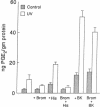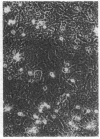Abstract
Acute ultraviolet light B (UVB) injury is associated with dermal mast cell histamine release. The possibility that histamine-stimulated prostaglandin (PG) synthesis could be a mechanism for irradiation erythema was therefore examined using human skin explants. Explants responded to UV irradiation (120 mJ/cm2) with a fivefold increase in synthesis of prostaglandins E2, F2 alpha and 6-keto PGF1 alpha. Incubating explants with the H1 antihistamines brompheniramine (50 microM) or pyrilamine (30 microM) inhibited PG release from irradiated explants 63 +/- 4.9% (mean +/- SEM) 6 h after UV exposure. Antihistamines did not affect PG synthesis in control explants. Irradiation increased the histamine concentration in explant conditioned medium only 50% over basal values, suggesting that irradiation enhanced histamine responsiveness. Explants were therefore incubated with exogenous histamine. In irradiated explants, PG synthesis was stimulated threefold by 3 microM histamine. Unirradiated explants' PG synthesis was unaffected by histamine. Enhanced histamine sensitivity was also examined in epidermal cell cultures. In irradiated cultures, histamine sensitivity was again markedly potentiated: as little as 1 microM histamine stimulated significant PGE2 release and the response to 10-30 microM histamine was increased six to eight times compared with that of unirradiated cultures. These studies demonstrate that endogenous histamine stimulates PG synthesis in human skin after UV injury by potentiation of histamine-induced prostaglandin release. Potentiated agonist responses induced by UV exposure may contribute to the effects of UVB irradiation injury and in particular to irradiation erythema.
Full text
PDF
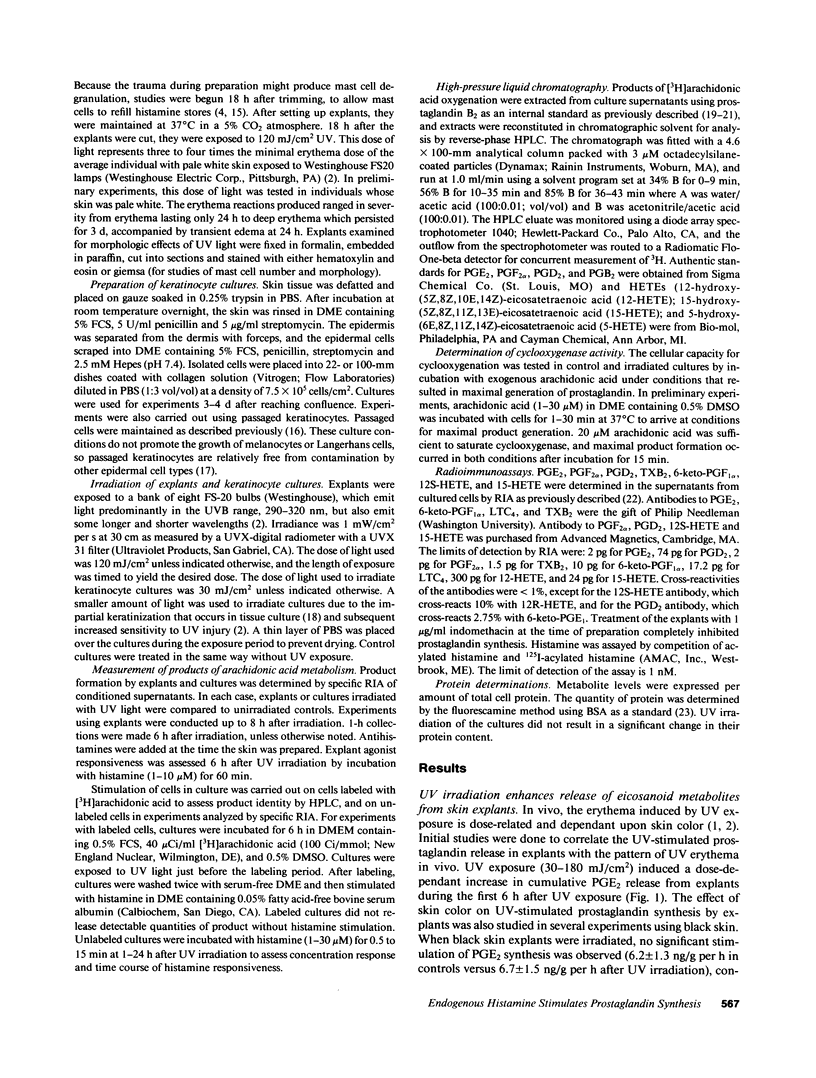

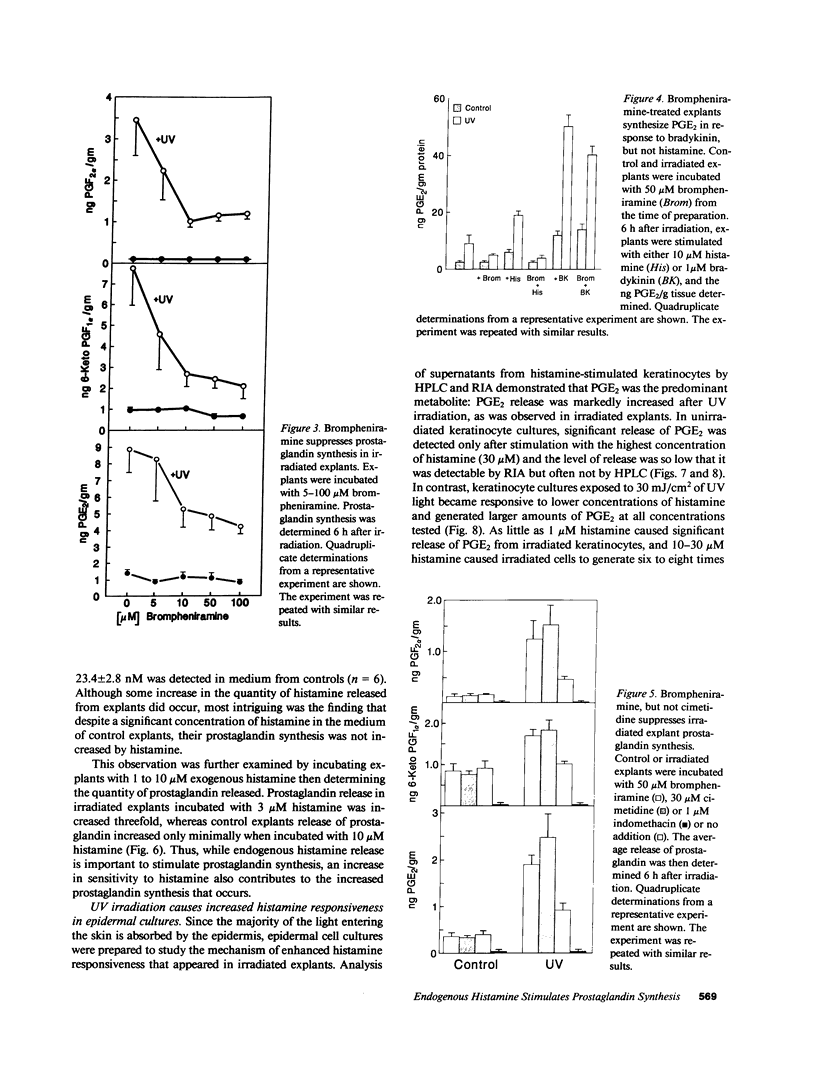
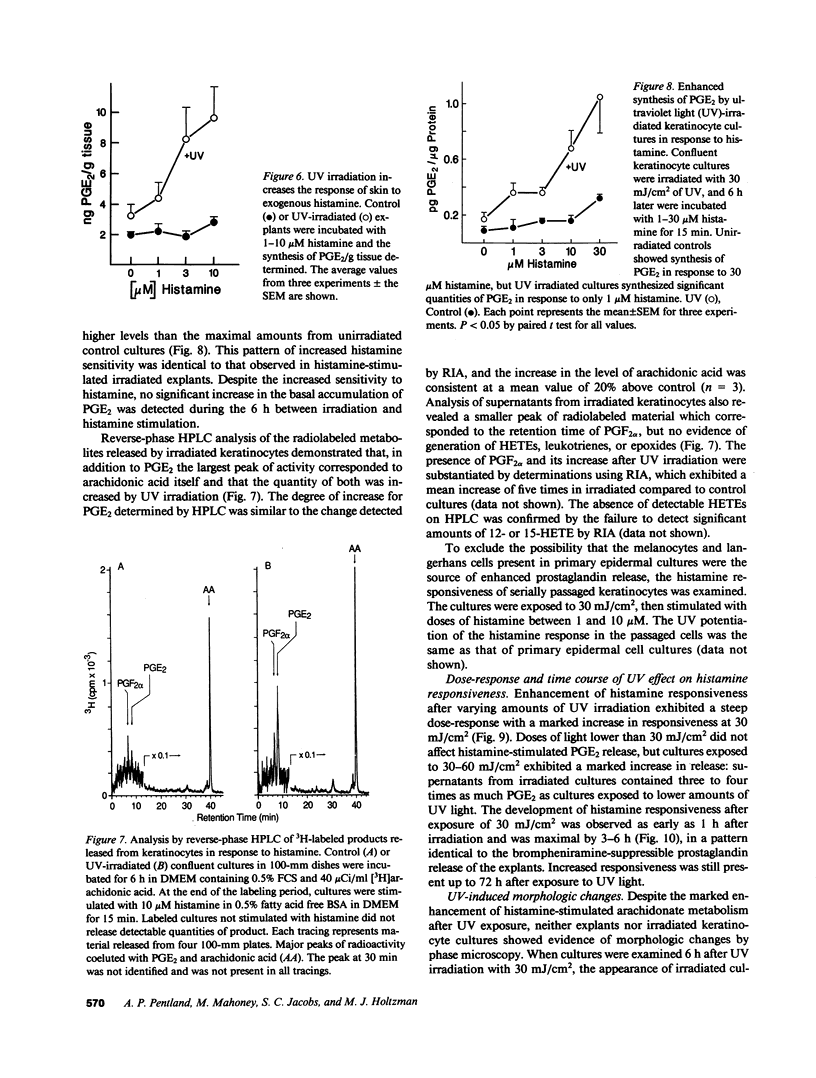
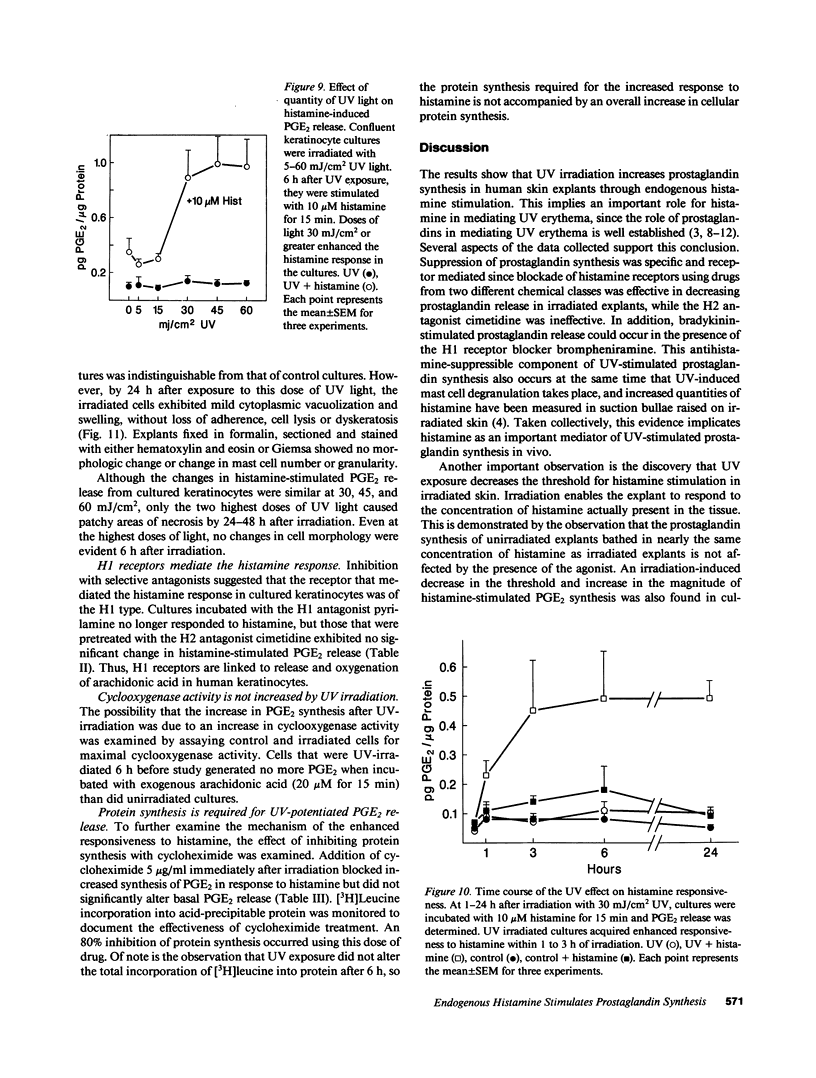
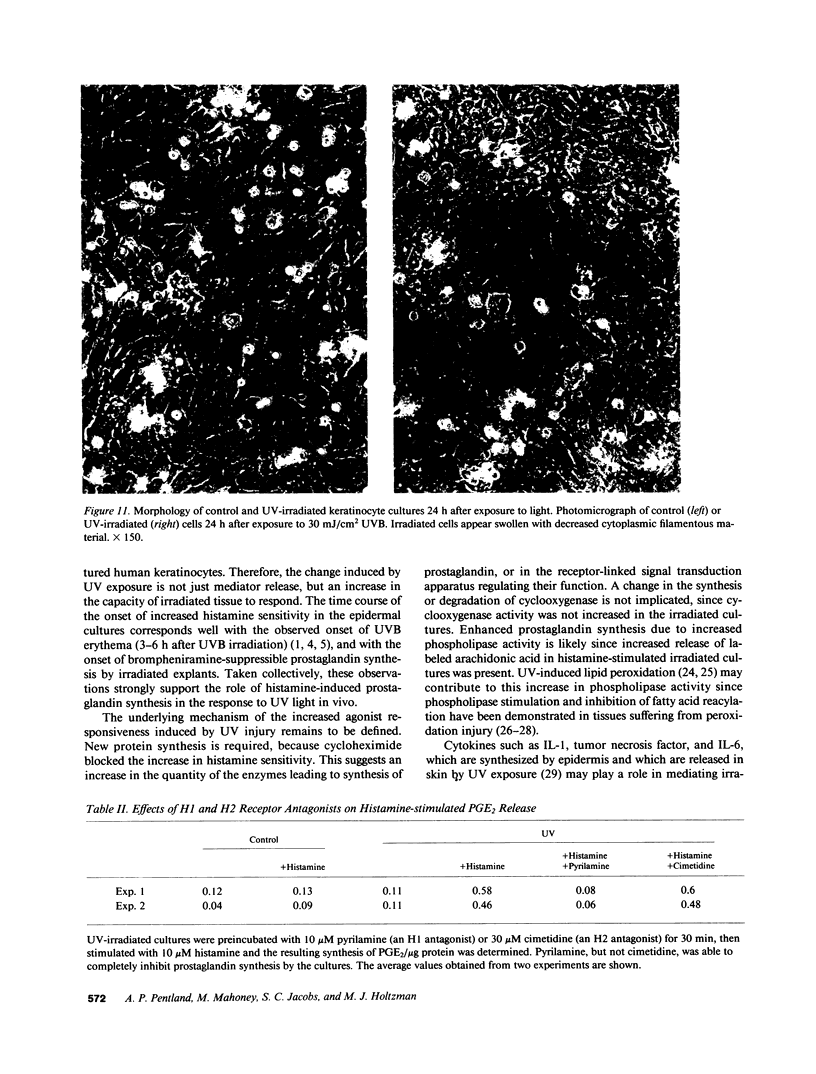
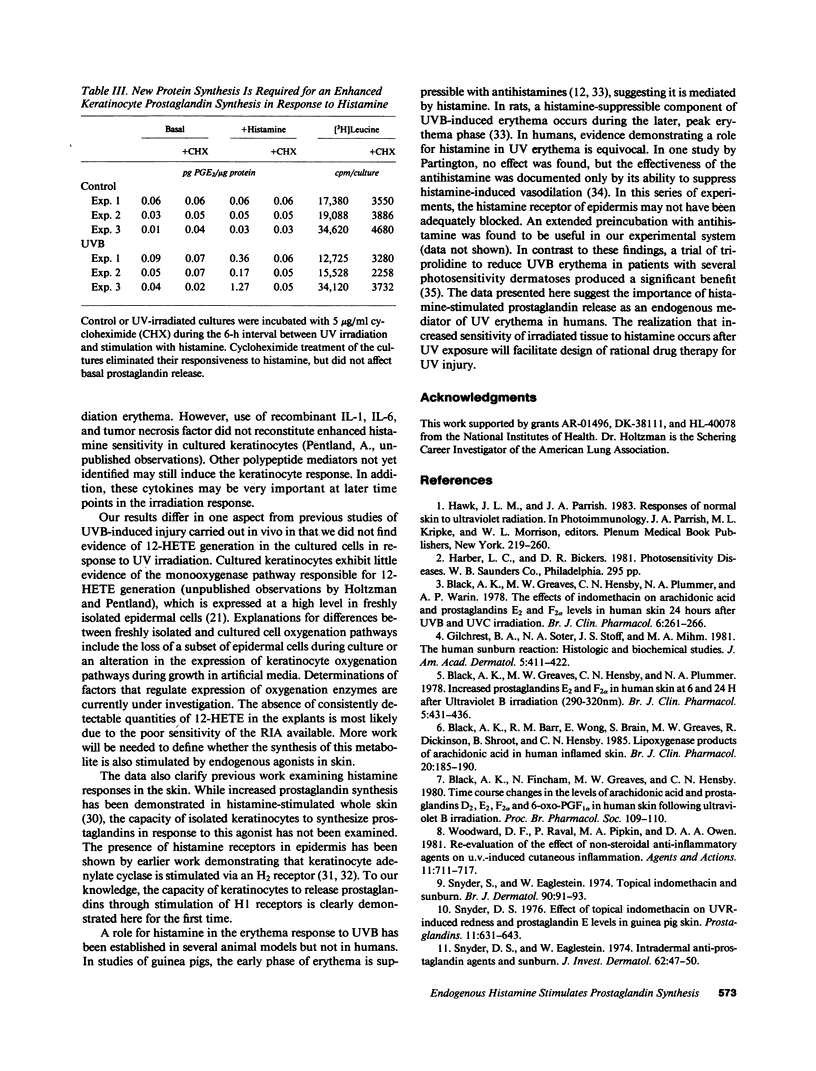
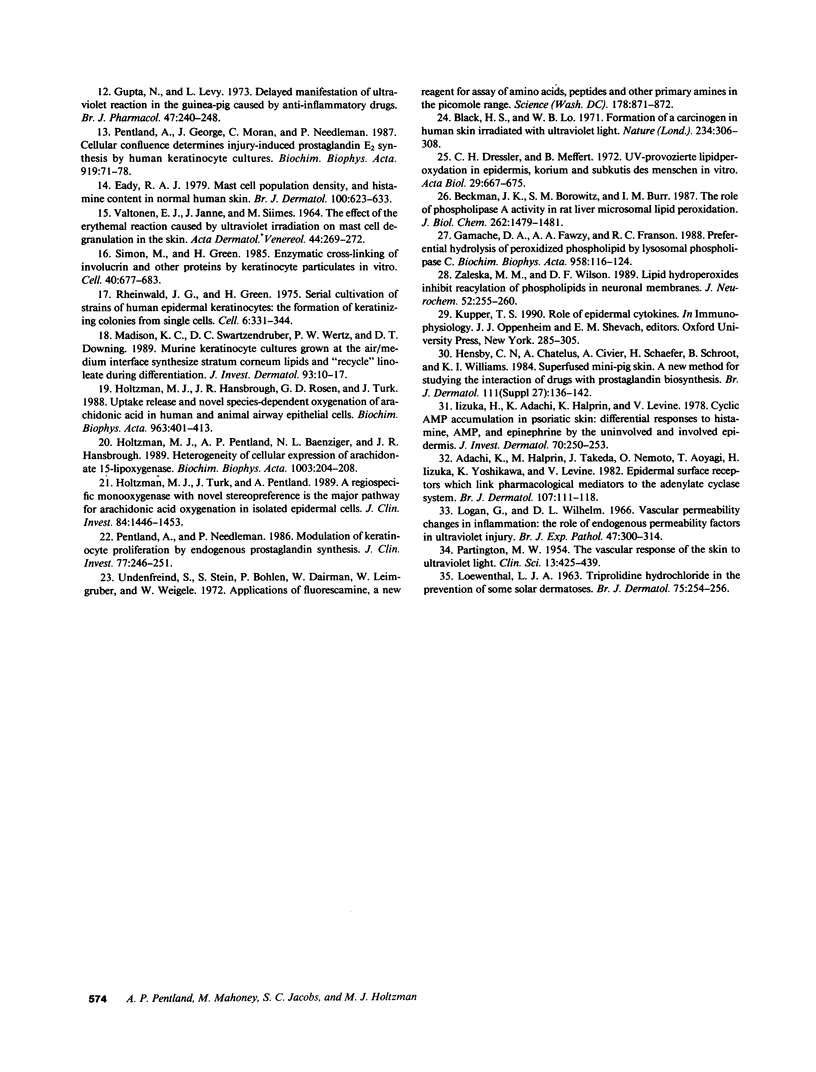
Images in this article
Selected References
These references are in PubMed. This may not be the complete list of references from this article.
- Adachi K., Halprin K. M., Takeda J., Nemoto O., Aoyagi T., Iizuka H., Yoshikawa K., Levine V. Epidermal surface receptors which link pharmacological mediators to the adenylate cyclase system. Br J Dermatol. 1982 Nov;107 (Suppl 23):111–118. doi: 10.1111/j.1365-2133.1982.tb01042.x. [DOI] [PubMed] [Google Scholar]
- Beckman J. K., Borowitz S. M., Burr I. M. The role of phospholipase A activity in rat liver microsomal lipid peroxidation. J Biol Chem. 1987 Feb 5;262(4):1479–1484. [PubMed] [Google Scholar]
- Black A. K., Barr R. M., Wong E., Brain S., Greaves M. W., Dickinson R., Shroot B., Hensby C. N. Lipoxygenase products of arachidonic acid in human inflamed skin. Br J Clin Pharmacol. 1985 Sep;20(3):185–190. doi: 10.1111/j.1365-2125.1985.tb05059.x. [DOI] [PMC free article] [PubMed] [Google Scholar]
- Black A. K., Greaves M. W., Hensby C. N., Plummer N. A. Increased prostaglandins E2 and F2alpha in human skin at 6 and 24 h after ultraviolet B irradiation (290- 320 nm). Br J Clin Pharmacol. 1978 May;5(5):431–436. doi: 10.1111/j.1365-2125.1978.tb01650.x. [DOI] [PMC free article] [PubMed] [Google Scholar]
- Black A. K., Greaves M. W., Hensby C. N., Plummer N. A., Warin A. P. The effects of indomethacin on arachidonic acid and prostaglandins e2 and f2alpha levels in human skin 24 h after u.v.B and u.v.C irradiation. Br J Clin Pharmacol. 1978 Sep;6(3):261–266. doi: 10.1111/j.1365-2125.1978.tb04595.x. [DOI] [PMC free article] [PubMed] [Google Scholar]
- Black H. S., Lo W. B. Formation of a carcinogen in human skin irradiated with ultraviolet light. Nature. 1971 Dec 3;234(5327):306–308. doi: 10.1038/234306a0. [DOI] [PubMed] [Google Scholar]
- Eady R. A., Cowen T., Marshall T. F., Plummer V., Greaves M. W. Mast cell population density, blood vessel density and histamine content in normal human skin. Br J Dermatol. 1979 Jun;100(6):623–633. doi: 10.1111/j.1365-2133.1979.tb08065.x. [DOI] [PubMed] [Google Scholar]
- Gamache D. A., Fawzy A. A., Franson R. C. Preferential hydrolysis of peroxidized phospholipid by lysosomal phospholipase C. Biochim Biophys Acta. 1988 Jan 19;958(1):116–124. doi: 10.1016/0005-2760(88)90252-4. [DOI] [PubMed] [Google Scholar]
- Gilchrest B. A., Soter N. A., Stoff J. S., Mihm M. C., Jr The human sunburn reaction: histologic and biochemical studies. J Am Acad Dermatol. 1981 Oct;5(4):411–422. doi: 10.1016/s0190-9622(81)70103-8. [DOI] [PubMed] [Google Scholar]
- Gupta N., Levy L. Delayed manifestation of ultraviolet reaction in the guinea-pig caused by anti-inflammatory drugs. Br J Pharmacol. 1973 Feb;47(2):240–248. doi: 10.1111/j.1476-5381.1973.tb08321.x. [DOI] [PMC free article] [PubMed] [Google Scholar]
- Hensby C. N., Chatelus A., Civier A., Schaefer H., Shroot B., Williams K. I. Superfused mini-pig skin. A new method for studying the interaction of drugs with prostaglandin biosynthesis. Br J Dermatol. 1984 Jul;111 (Suppl 27):136–142. doi: 10.1111/j.1365-2133.1984.tb15591.x. [DOI] [PubMed] [Google Scholar]
- Holtzman M. J., Hansbrough J. R., Rosen G. D., Turk J. Uptake, release and novel species-dependent oxygenation of arachidonic acid in human and animal airway epithelial cells. Biochim Biophys Acta. 1988 Dec 16;963(3):401–413. doi: 10.1016/0005-2760(88)90308-6. [DOI] [PubMed] [Google Scholar]
- Holtzman M. J., Pentland A., Baenziger N. L., Hansbrough J. R. Heterogeneity of cellular expression of arachidonate 15-lipoxygenase: implications for biological activity. Biochim Biophys Acta. 1989 Jun 8;1003(2):204–208. doi: 10.1016/0005-2760(89)90257-9. [DOI] [PubMed] [Google Scholar]
- Holtzman M. J., Turk J., Pentland A. A regiospecific monooxygenase with novel stereopreference is the major pathway for arachidonic acid oxygenation in isolated epidermal cells. J Clin Invest. 1989 Nov;84(5):1446–1453. doi: 10.1172/JCI114319. [DOI] [PMC free article] [PubMed] [Google Scholar]
- Iizuka H., Adachi K., Halprin K. M., Levine V. Cyclic AMP accumulation in psoriatic skin: differential responses to histamine, AMP, and einephrine by the uninvolved and involved epidermis. J Invest Dermatol. 1978 May;70(5):250–253. doi: 10.1111/1523-1747.ep12541392. [DOI] [PubMed] [Google Scholar]
- Logan G., Wilhelm D. L. Vascular permeability changes in inflammation. I. The role of endogenous permeability factors in ultraviolet injury. Br J Exp Pathol. 1966 Jun;47(3):300–314. [PMC free article] [PubMed] [Google Scholar]
- Madison K. C., Swartzendruber D. C., Wertz P. W., Downing D. T. Murine keratinocyte cultures grown at the air/medium interface synthesize stratum corneum lipids and "recycle" linoleate during differentiation. J Invest Dermatol. 1989 Jul;93(1):10–17. doi: 10.1111/1523-1747.ep12277335. [DOI] [PubMed] [Google Scholar]
- Meffert H., Dressler C., Meffert B. UV-provozierte Lipidperoxydation in Epidermis, Korium und Subkutis des Menschen in vitro. Acta Biol Med Ger. 1972;29(4):667–675. [PubMed] [Google Scholar]
- PARTINGTON M. W. The vascular response of the skin to ultra-violet light. Clin Sci. 1954 Aug;13(3):425–439. [PubMed] [Google Scholar]
- Pentland A. P., George J., Moran C., Needleman P. Cellular confluence determines injury-induced prostaglandin E2 synthesis by human keratinocyte cultures. Biochim Biophys Acta. 1987 May 13;919(1):71–78. doi: 10.1016/0005-2760(87)90219-0. [DOI] [PubMed] [Google Scholar]
- Pentland A. P., Needleman P. Modulation of keratinocyte proliferation in vitro by endogenous prostaglandin synthesis. J Clin Invest. 1986 Jan;77(1):246–251. doi: 10.1172/JCI112283. [DOI] [PMC free article] [PubMed] [Google Scholar]
- Rheinwald J. G., Green H. Serial cultivation of strains of human epidermal keratinocytes: the formation of keratinizing colonies from single cells. Cell. 1975 Nov;6(3):331–343. doi: 10.1016/s0092-8674(75)80001-8. [DOI] [PubMed] [Google Scholar]
- Simon M., Green H. Enzymatic cross-linking of involucrin and other proteins by keratinocyte particulates in vitro. Cell. 1985 Mar;40(3):677–683. doi: 10.1016/0092-8674(85)90216-8. [DOI] [PubMed] [Google Scholar]
- Snyder D. S., Eaglstein W. H. Topical indomethacin and sunburn. Br J Dermatol. 1974 Jan;90(1):91–93. [PubMed] [Google Scholar]
- Snyder D. S. Effect of topical indomethacin on UVR-induced redness and prostaglandin E levels in sunburned guinea pig skin. Prostaglandins. 1976 Apr;11(4):631–643. doi: 10.1016/0090-6980(76)90066-6. [DOI] [PubMed] [Google Scholar]
- Udenfriend S., Stein S., Böhlen P., Dairman W., Leimgruber W., Weigele M. Fluorescamine: a reagent for assay of amino acids, peptides, proteins, and primary amines in the picomole range. Science. 1972 Nov 24;178(4063):871–872. doi: 10.1126/science.178.4063.871. [DOI] [PubMed] [Google Scholar]
- Woodward D. F., Raval P., Pipkin M. A., Owen D. A. Re-evaluation of the effect of non-steroidal anti-inflammatory agents on u.v.-induced cutaneous inflammation. Agents Actions. 1981 Dec;11(6-7):711–717. doi: 10.1007/BF01978794. [DOI] [PubMed] [Google Scholar]
- Zaleska M. M., Wilson D. F. Lipid hydroperoxides inhibit reacylation of phospholipids in neuronal membranes. J Neurochem. 1989 Jan;52(1):255–260. doi: 10.1111/j.1471-4159.1989.tb10925.x. [DOI] [PubMed] [Google Scholar]



